10 Exciting Technologies From WEFTEC

By Kevin Westerling,
@KevinOnWater
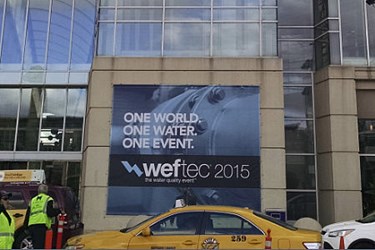
Judging by WEFTEC 2015, the water industry is on a roll.
Hosted by the Water Environment Federation (WEF) and held at Chicago’s McCormick Place in late September, the 88th annual conference and exposition once again broke all records for size and attendance with 311,600 square feet of floor space covered, 1,033 exhibitors, and 25,048 registrants.
Despite the industry’s persistent, significant challenges — and perhaps because of them — there was an air of excitement in the Windy City about the future, specifically with regard to new technology. The exposition offered plenty of forward-looking possibilities with row after row of product innovations, each (on some level) designed to improve efficiency and save resources. “There is no waste, only wasted resources” was a recurring quote in sessions and speeches, reflective of industry aspirations and WEFTEC’s technological focus.
Among the many, here are 10 exciting products that caught my eye.
Packaged Coagulation/Flocculation System – Westfall Manufacturing Company
While coagulation and flocculation are typically handled in distinct phases, Westfall has revolutionized the process by performing both actions in a short, straight pipeline. Two mixers are incorporated — one that provides rapid mixing to disperse the coagulant, and a second that mixes gently to promote flocculation. The all-in-one mixing is more efficient and space-saving than traditional serpentine flocculation piping.
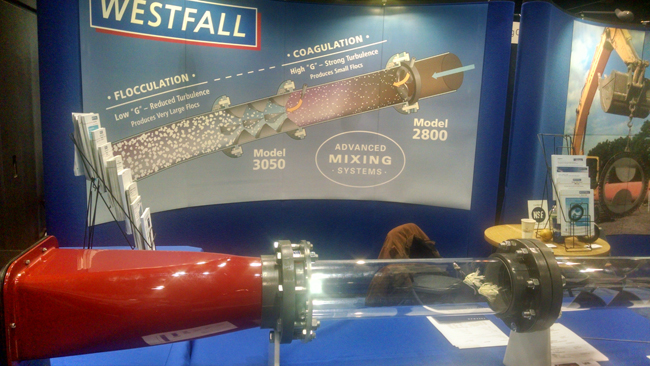
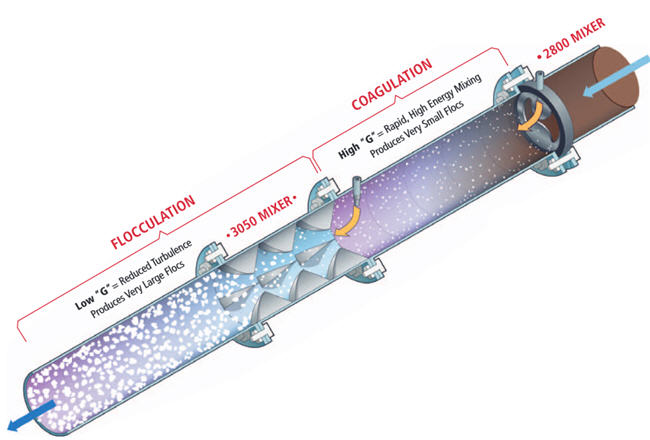
LucidPipe Power System – Lucid Energy Inc.
Lucid Energy also focuses its energy inside the pipe — literally. The company, which was part of WEFTEC’s Innovation Showcase, provides in-pipe turbine generators that recover energy to produce electricity for on-site use or to serve back to the grid. Designed for gravity-fed pipes of 24- to 96-inch diameter, they are suitable for drinking water distributions systems, wastewater effluent streams, industrial process/cooling systems, or agricultural water. The energy is clean and renewable (with production based on flow rate), and the turbines won’t disrupt the flow of water. According to Lucid, the system can be installed in a day and begin generating energy (and saving money) within a week.
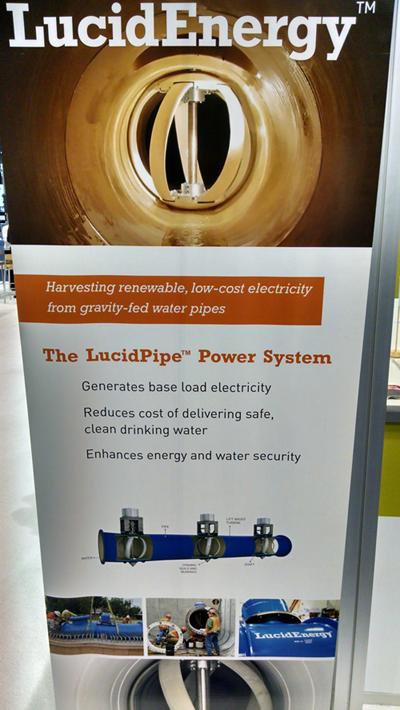
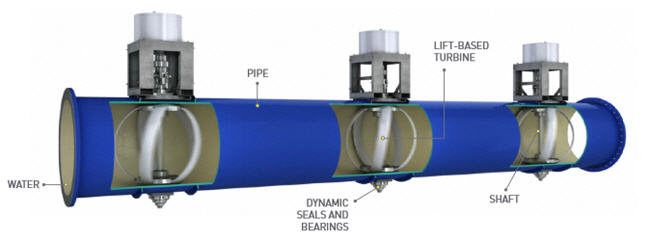
Algaewheel – OneWater Inc.
As decentralized wastewater treatment becomes more popular and prevalent, an obvious concern is how a system integrates into the community it serves. In addition to how it looks, smells, and sounds, communities respond well to systems that are efficient and environmentally friendly. The Algaewheel from OneWater satisfies these demands by treating wastewater with no mechanical drives or blowers, and with up to 80 percent less power than traditional alternatives. The wheels are filled with moving-bed bioreactor (MBBR) media and promote the growth of an algae biofilm, which hosts a diverse set of bacteria. Oxygen to sustain the ecosystem is generated by photosynthetic aeration and the natural rotation of the wheels. The modular system is housed in a greenhouse-reminiscent ‘ecostructure,’ and is ideal for applications of 5,000 to 200,000 GPD.
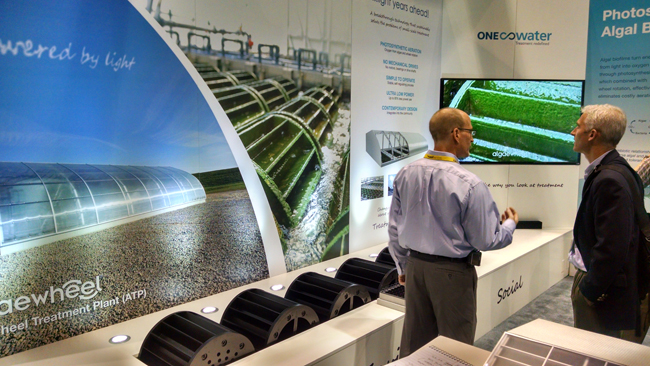
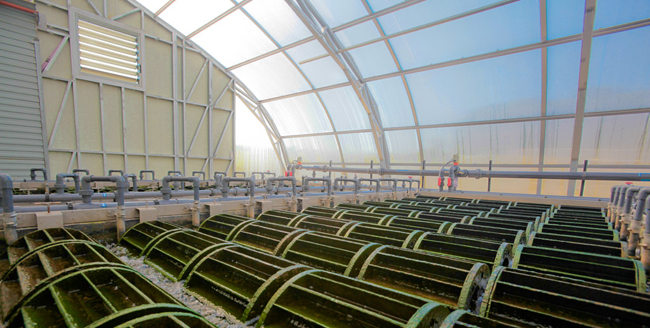
Liquiline Colorimetric Analyzers For Phosphorus And Ammonia – Endress+Hauser
Back at the plant, many centralized utilities are struggling to comply with strict nutrient limits. Precise sampling, measurement, and dosing are the keys to keeping costs down while keeping in compliance. According to Tracy Doane-Weideman, the product manager behind the Liquiline CA80PH (phosphorus) and CA80AM (ammonia) analyzers, sample-taking is by far the most important step in for successful monitoring, and operator error puts results at risk. These analyzers eliminate manual sampling procedures by automatically obtaining the water sample, filtering it, adding reagent, and measuring the intensity. The sampling system then cleans itself with compressed air or water in preparation for the next test. The CA80AM achieves direct cost savings by reducing blower expenses in the aeration basin, while the CA80PH can reduce chemical precipitant consumption by a factor of 8. They both incorporate standard colorimetric measuring methods, and the Liquiline System design is both familiar and ‘plug-and-play’ — ease of use being of chief concern.
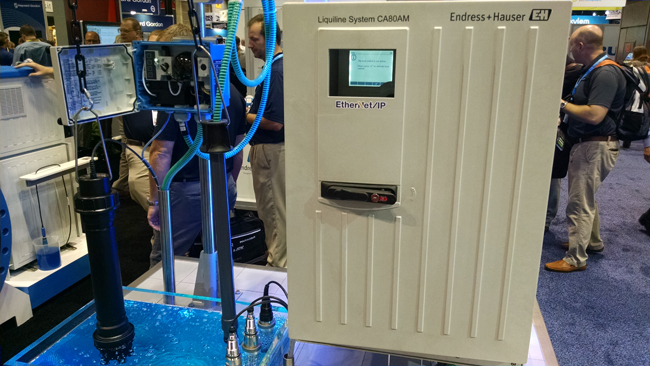
Deep Trekker Underwater ROV – Deep Trekker Inc.
Some products at WEFTEC are striking for their practical benefit — and some, frankly, are just cool. The Deep Trekker ROV (remotely operated vehicle) has both attributes, featuring a game-style controller to guide an underwater camera through inspections of potable water tanks or underwater infrastructure. While ROVs are not new to the scene, the Deep Trekker dispenses of the heavy control boxes and power requirements that plagued its forebears. Quick-recharge batteries last 6 to 8 hours, and a lightweight tether (and corresponding depth rating) allows for 410 feet of exploration with the DTG2 model and 1,000 feet with the DTX2. The ROV needs only one high-definition, low-light camera to see in all directions due to thrusters, a patented pitching system, and controls that enable 360-degree viewing with a 270-degree camera sweep and 180-degree pitch angle. As should be expected, the body is corrosion-resistant, made from anodized, epoxy-coated cast aluminum.
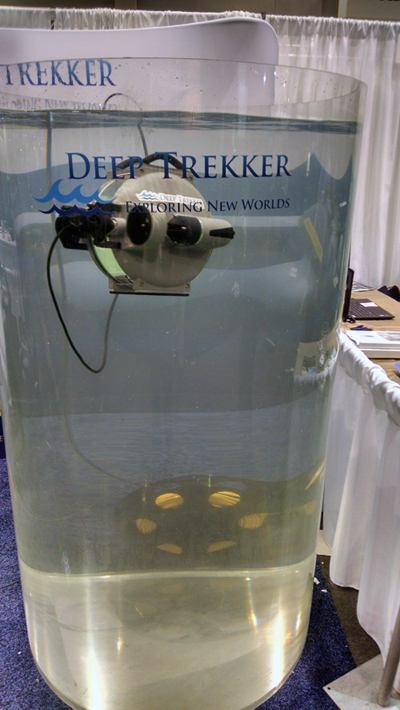
Fuzzy Filter – Schreiber LLC
The name sounds a bit funny, but it’s catchy and entirely accurate. The fuzzy balls in Schreiber’s new wastewater filtration unit are seriously unique in that they can be compressed to adjust porosity. Compared to a typical sand filter, the Fuzzy Filter unit is 15 percent smaller, yet can handle up to five times the flow rate at 40-plus GPM per square foot. And despite their light and airy composition, the filters can last beyond 10 years. They can hold a high amount of solids, and are cleaned with a media backwash blower (no filtered water needed). Schreiber invites facility managers to try the Fuzzy Filter on-site for their wastewater or combined sewer overflow (CSO) application by offering it in a pilot unit trailer, seen below — inside and out.

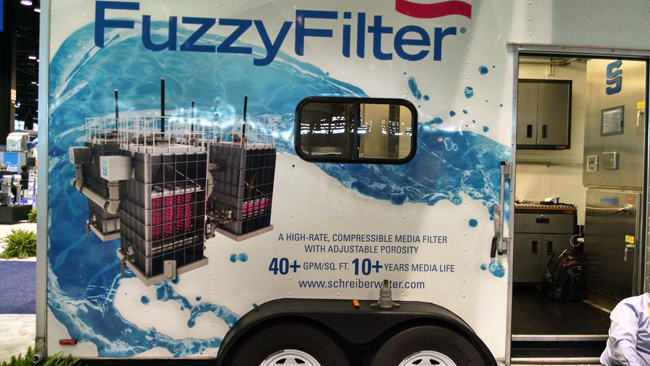
SolidStream Biosolids Treatment – Cambi
It was big news recently when DC Water went online with its thermal hydrolysis process (THP) provided by Cambi — a bold move for the utility, which is one of the most innovative in the country. THP is certainly gaining steam in the industry, but that technology is old compared to SolidStream, first introduced in 2014. The SolidStream process degrades extracellular polymeric substances to increase dewaterability, resulting in 40 to 60 percent dry solids. Meanwhile, expectations for conventional digestion typically hover around 20 to 25 percent dry solids. Doing the math, that’s a 75 percent reduction in water volume for SolidStream, and a sizable reduction in costs for disposal. Furthermore, SolidStream treatment results in Class A, pathogen-free biosolids for beneficial reuse as a fertilizer — clean enough to grow crops.
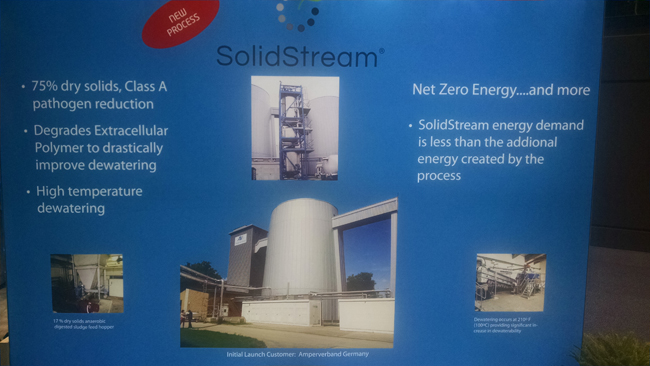
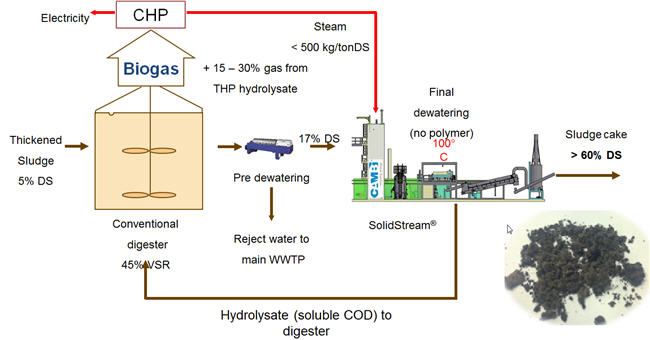
LaserFlow Velocity Sensor – Teledyne Isco
When scouring for innovation, lasers on the show floor tend to gain attention. Deservedly so for the LaserFlow, which measures level and velocity in open-flow wastewater applications with a non-contact ultrasonic sensor and laser signal(s) sent below the surface. This method provides reliable monitoring even when the water is turbulent, while avoiding deadband measurement points. It is designed specifically for shallow flow measurement in small and large pipes, and is built to withstand — and continue to measure — in submerged conditions. The single or multiple laser beams can be adjusted remotely, avoiding the need to crawl into a confined space to adjust for condition changes.
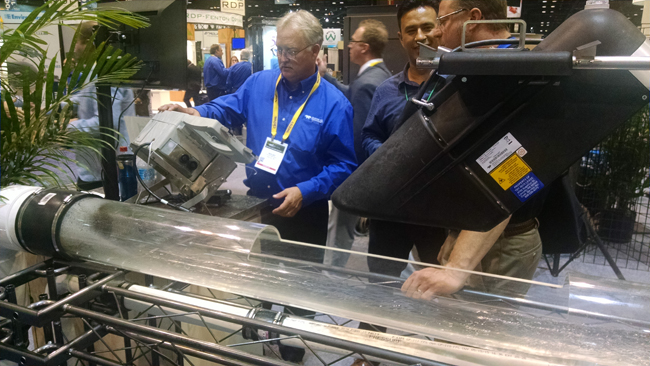
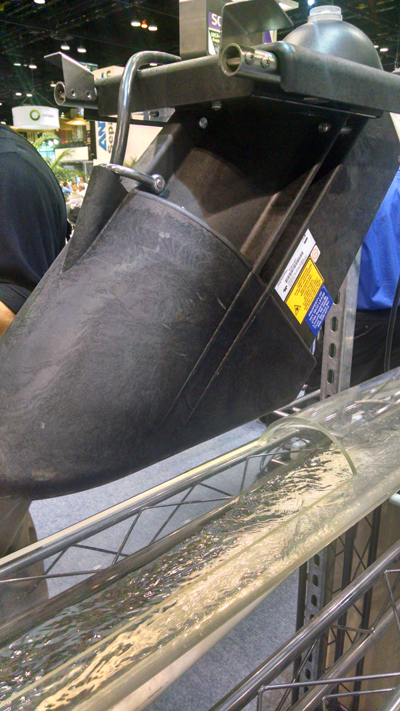
VigorOx WWT II Disinfectant – PeroxyChem
The use of paracetic acid (PAA) for wastewater disinfection is on the rise, as evidenced by the number of WEFTEC sessions devoted to the topic and the activity at PeroxyChem’s booth. VigorOx WWT II is a PAA formulation that substitutes for chlorine to kill pathogens such as E. coli, fecal coliforms, and streptococci. It’s stronger than chlorine, however — dose rates are lower (ranging from 1 to 3 mg/L) and contact times are shorter (10 to 30 minutes) with PAA. Other benefits include: lower toxicity to aquatic life, with no need to de-chlorinate before discharging into receiving waters; no highly toxic or carcinogenic disinfection byproducts are formed; and no reaction with ammonia, whereas ammonia degrades the performance of chlorine as plants go in and out of nitrification. PeroxyChem offers VigorOx WWT II as an ‘end-to-end solution’ — including chemical supply; storage, feed, and control equipment; and installation, startup, and maintenance services — and equipment is leased to the municipality to minimize capital expense. The company will also facilitate bench tests, pilots, and trials for regulatory approval and National Pollutant Discharge Elimination System (NPDES) permit changes.
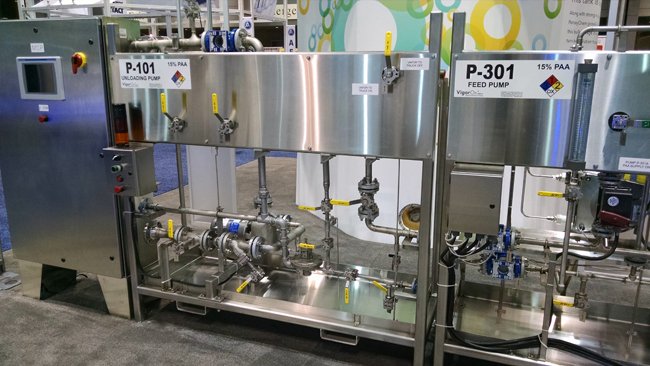
World’s Largest Submersible Pump – Flygt -- A Xylem Brand
It’s fair to say that show-goers probably had never before seen a pump quite like the one showcased at Xylem’s booth, because it’s the world’s largest production submersible pump. The flow rate on this channel impeller pump is 50,000 GPM and it weighs in a 22,500 pounds. It features a 1,250-HP motor, a 32" diameter discharge, and handles heads up to 150 feet. The timing of the milestone display aligned nicely with a milestone achievement — Xylem announced at WEFTEC that it had just sold its four-millionth wastewater pump.
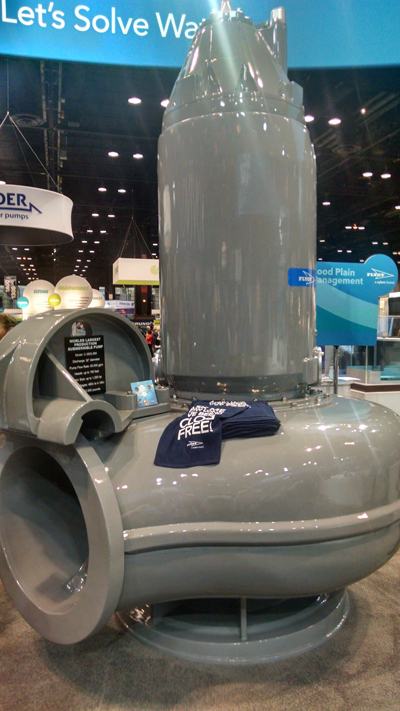
Yes, everything was a bit bigger this year at WEFTEC — a show that, in its recent history, continues to outdo itself in terms of scale and level of innovation. It will be fun to watch the industry follow suit with the next generation of solutions for infrastructure renewal.
